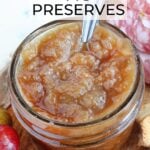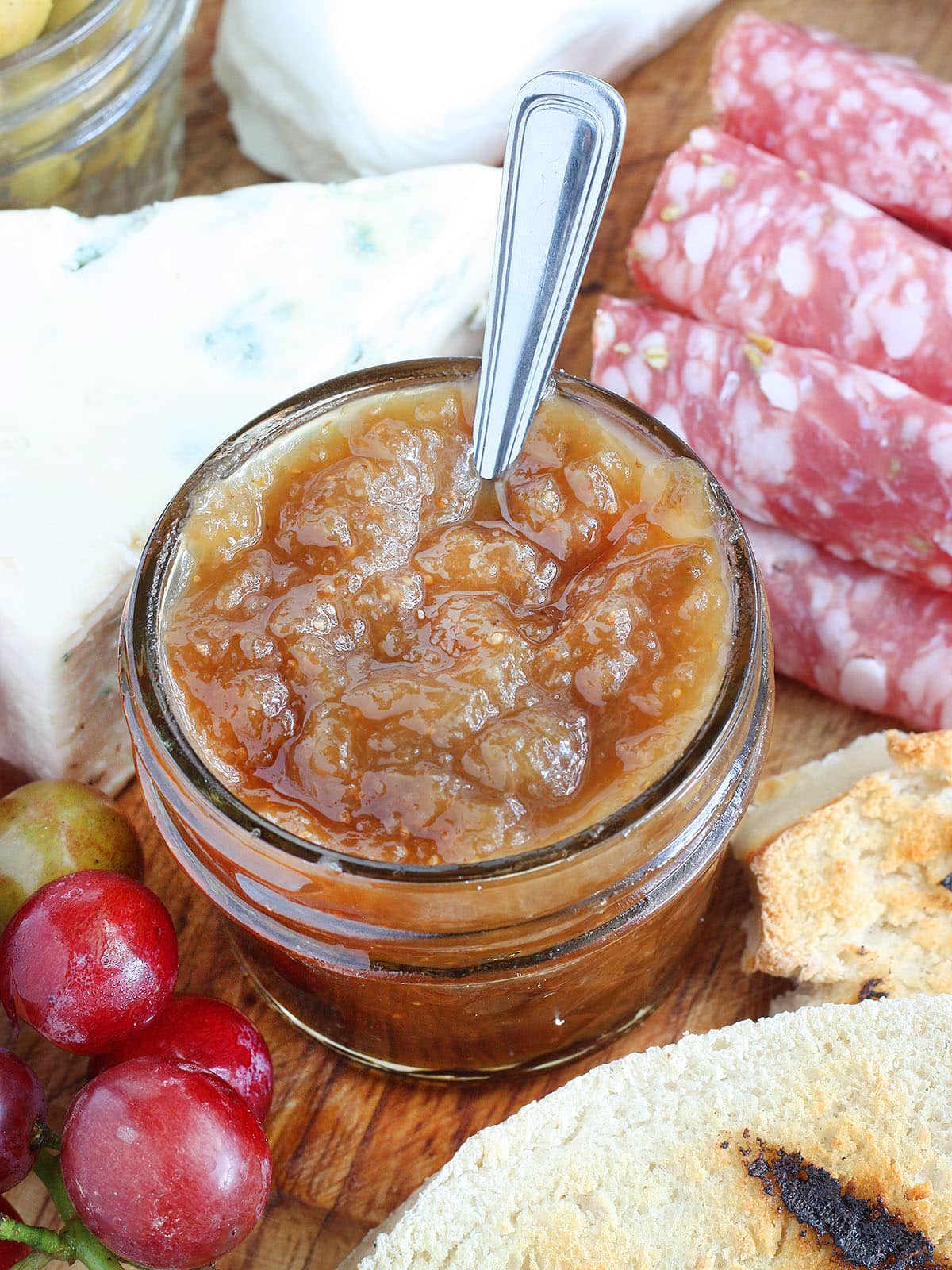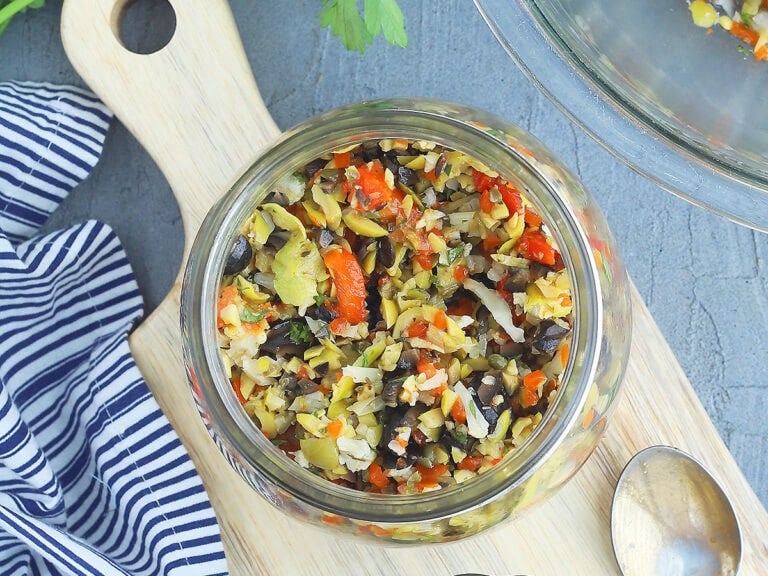Homemade Fig Preserves
This simple homemade fig preserves recipe contains only five ingredients. But the flavor is undeniably delicious. Whip up a batch today!
This post may contain affiliate links. Click here to learn more about how affiliate links are used on this site.
When I was a little girl, my dad planted a fig tree in my parent’s front yard. Over the last 30-something plus years, it has produced quite a lot of figs. Every year, my parents share their bounty with me, which I promptly freeze until spring when I can make my Strawberry Fig Preserves as soon as Louisiana strawberries are in season.
A few months ago, I was taking a much-needed inventory of my freezer and I unearthed SO MANY forgotten bags of frozen figs. Strawberry season was over. What else could I do with them? Every summer when The Husband and I take our annual beach trip with the family, we steal away one night for a date at our favorite restaurant. We’ve been going to this restaurant for so long, we’ve started to notice subtle changes in the menu, like the addition of a dollop of fig jam to our favorite meat and cheese tray. It’s such a wonderful accompaniment, I end up putting a smear of fig jam onto pretty much everything. There was no question what I would do with those forgotten bags of figs.
Best figs to use for jam
My dad’s tree produces Celeste figs. They are small, about the size of a quarter, with greenish brown skins and pink insides. Brown Turkey and Kadota figs are also great options; however, I think this recipe would work for any type of fig.
That being said, some fig types have thicker skins and you may wonder if they should be peeled first. I’ve never found this to be a problem. The skins tend to break down and get soft as they cook. I frequently freeze my figs until I have time to use them. The act of freezing and thawing breaks down both the figs and the skin. Therefore, I’ve never had to peel my figs. I simply trim the stems.
Ingredients and tools you’ll need
Can you believe this recipe only requires five ingredients? To get started, you’ll need:
- 6 cups stemmed and chopped figs
- 3 1/2 cups granulated sugar
- 1/4 cup bottled lemon juice
- 3 teaspoons lemon zest, optional
- 1/4 teaspoon grated nutmeg, optional
- Large stock pot with a lid
Prepare the fruit
First, trim and chop the figs. You can also pulse the figs in a blender or food processor to further break down the fruit. Place the fruit in a large saucepan. Add the white granulated sugar to the pot and stir to combine. Let the fruit and sugar sit for two hours to allow the sugar to draw out the natural juice in the figs.


Storage
While the preserves are still hot, transfer to clean jars and seal with a lid. If the preserves still seem a bit runny, don’t worry. They will continue to thicken as they cool. This could take up to 48 hours. Once the figs have cooled, store them in the refrigerator. Consume within three months.
Fig preserves can also be frozen. Store the preserves in plastic containers rather than glass, as glass can shatter when exposed to extreme temperatures. Be sure to leave some room for expansion. Consume with preserves within three months. Allow them to thaw in the refrigerator before using.
Canning instructions
If you want to store the preserves for longer, they can be preserved using the water bath canning method. Fill clean glass jars, leaving ¼-inch of headspace. Top with lids and rings, then process for 10 minutes. After 24 hours, check the lids for a seal. Any unsealed jars need to be stored in the refrigerator. If the canned preserves are stored in a cool, dry place, they will last up to 18 months.
To learn more about water bath canning, check out my tutorial on the basics of water bath canning.
Ideas for using fig preserves
Fig preserves is a delicious accompaniment for hot biscuits, as a glaze for chicken or pork, poured over hot brie or swirled into a morning bowl of oatmeal. You can also whisk it with a little olive oil, balsamic vinegar, salt and pepper to make a delicious fig vinaigrette for salad.
Of course, I’m partial to the meat and cheese tray. In addition to the fig preserves, some delicious sliced meats and gourmet cheese, consider adding a few spicy pickled okra, chipotle pimento cheese, and brandy infused mini cheese balls to your board.
Frequently asked questions
If you plan on canning these preserves, it’s very important to use bottled lemon juice. Figs do not naturally contain a lot of acid, which is needed to prevent the formation of bacteria during the canning process. We have to add some in the form of lemon juice. The acidity from lemon to lemon can vary, that’s why I don’t advise using freshly squeezed lemon juice. Bottled lemon juice has a consistent acid level and is what I recommend.
Don’t I need to add pectin?
Most of my other jam and jelly recipes call for pectin. Pectin is a naturally occurring soluble fiber that also works as a thickener. Some fruits, such as apples, contain a lot of pectin naturally. Figs do not, but surprisingly, you don’t need to add any additional pectin. The reason is, as the figs cook down the natural sugars in the figs combine with the added sugar and form a thick syrup.
How can I tell if my preserves have set?
The preserves will continue to thicken as they cool. But if you are impatient like me, you can use something called the spoon test. Place a clean metal spoon in the freezer (I like to stick mine down in the ice bin) before you get started. When the preserves come off the burner, remove the spoon from the freezer and dribble a few drops onto the cold spoon. This will give you a pretty good idea of how well your preserves will thicken.
What if my preserves don’t thicken?
If you’ve done the spoon test and you still don’t feel like your preserves are the consistency you’re looking for, you can return it to the burner and cook it down for a little longer. If you’re still struggling with the consistency after that, try adding a bit of pectin. Add it a teaspoon at a time, letting the preserves boil for a few minutes between each addition, before adding another teaspoon.
How can I reduce the amount of sugar?
Sugar is really integral in causing the preserves to set. Therefore, you can’t cut the amount of sugar without adding something back in. To reduce the amount of sugar in this recipe, add one (1.75 ounce) box of Low or No Sugar Needed Pectin (four tablespoons if using bulk.) Reduce the amount of sugar to 1 1/2 cups. You can leave the sugar out entirely, but keep in mind, your preserves might be a bit on the runny side.
Can I use honey instead of sugar?
In preserves without pectin, you can replace up to half of the amount of sugar with honey. If using pectin (for example, in low sugar preserves) all of the sugar can be replace by honey.
Can I use artificial sweetener?
Yes. Follow the instructions listed above for low sugar preserves. Since artificial sweeteners are sweeter than regular sugar, substitute two tablespoons of sweetener for every one cup of sugar.

Homemade Fig Preserves
Ingredients
- 6 cups stemmed and chopped figs I used Celeste figs
- 3 1/2 cups granulated sugar
- 1/4 cup bottled lemon juice
- 3 teaspoons lemon zest optional
- 1/4 teaspoon nutmeg optional
Instructions
- In a large pot, combine the figs and sugar. Let them sit for about 2 hours.
- Add the lemon juice and stir to combine.
- Heat the pot over medium high heat until it comes to a boil.
- Cook down until the figs become very soft and the syrup begins to thicken, about 10-20 minutes.
- Remove the pan from the heat. Add the lemon zest and nutmeg, if desired.
- Preserves will continue to thicken for 24-48 hours.







![Three Ingredient Blackberry Jam [with or without seeds]](https://cookingbride.com/wp-content/uploads/2023/03/blackberry-jam-IMG_0471-H-768x576.jpg)





Hi, Madeline! If stored in the refrigerator, they should last 2-4 months. If canned, Ball recommends eating within 18 months. After that, the flavor or texture could be affected.
What is the shelf life of these preserves
Hi Patricia! Yes, the preserves can be canned. If you look under the heading “How To Store Fig Preserves” I go into more detail on that. They will definitely last longer. If stored in the refrigerator, they should last 2-4 months. If canned, Ball recommends eating within 18 months. After that, the flavor or texture could be affected. But honestly, if the seal on the jar is still intact, they can be eaten safely for years.
One done can they be canned and will they last longer this way? My mother used to can hers and we kept them in a canning room in the basement of our house they lasted forever it seemed – but she used fresh figs I’m goi g to be using frozen ones that once thawed I will make the preserves with .
Hi Anna! You can freeze this jam, but I would not store it in glass jars. Glass can shatter if it’s frozen too quickly or if you don’t leave enough room for expansion.
Can i freeze the fig preserve/jam in a small glass mason jar in the freezer??
Yes, it can.
Can this jam be stored in the freezer?
Thank you, Richard! That’s an interesting combo, I will have to give it a try.
Taste just great with feta cheese and toast